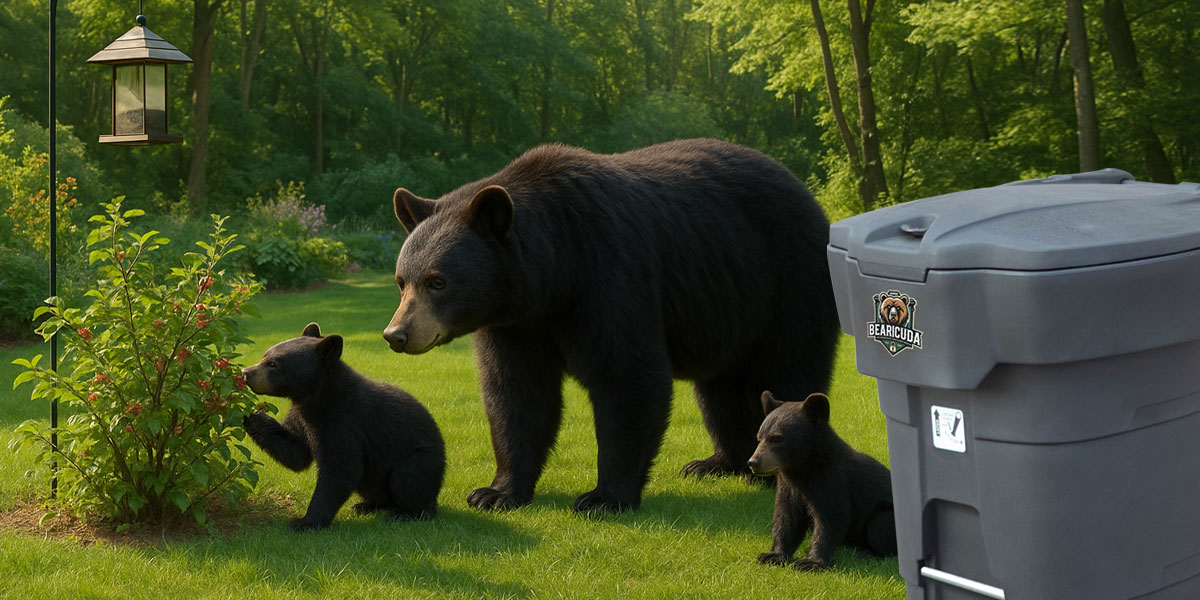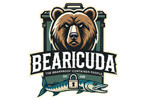Why Bears Are Attracted to Trash — and How to Stop It
Bears have extraordinary noses and opportunistic feeding habits. Ordinary carts, bins, and dumpsters act like billboards for calories—especially during hyperphagia (the seasonal bulk-up). The fix is a system: odor control, secure storage, consistent behavior, and certified bear-proof trash cans, enclosures, and dumpsters. Below you’ll find the science, the habits, and a step-by-step plan for residents, HOAs, and property managers—with product options from Bearicuda.

Why Bears Are Attracted to Trash — and How to Stop It
A bear-resistant trash can is an effective deterrent for grizzly, brown and black bears
Why Bears Smell Your Trash From So Far Away
- A nose built for distance. A black bear’s sense of smell is often cited as 7× better than a bloodhound’s and orders of magnitude more sensitive than ours. Airborne odor molecules from food scraps, grease, packaging, pet food, and even “cleaned” containers can telegraph an easy meal.
- Warm air lifts odors. On warm afternoons and evenings, scent plumes rise from bags, carts, and dumpsters. Wind carries those plumes along natural corridors—creek lines, fence gaps, alleys—straight to your property.
- Residue is enough. Even rinsed containers leave micro-films of fat and sugars. Bears can key on those trace compounds, especially when they’re calorie-stressed.
- Learning + memory. Once a bear succeeds at a location, it forms a strong spatial memory and returns, teaching cubs the same route. A single “reward” can create a repeating problem.
Implication: To defeat a bear’s nose, you need both odor management and physical containment.
Bearicuda's Basic and Stealth bear-resistant cans do both. They both provide an airtight seal to reduce food odors that attract bears as well as HD poly construction for structural integrity to deter bears from getting into your trash.
Bear Behavior That Drives Trash Conflicts
- Hyperphagia (late summer–fall). Bears spend up to 20 hours/day feeding to pack on fat before denning. Trash raids spike during this period—your tolerances and safeguards must be tighter then.
- Opportunism beats risk aversion. Bears balance easy calories against human proximity. If trash is accessible, the calorie reward usually wins.
- Route fidelity. Bears reuse the safest, fastest paths (tree lines, drainage swales, unlit back lanes). Light, fencing, and enclosure placement can disrupt these routes.
- Tool-like problem-solving. Bears push, pull, bounce, and drop containers to exploit weak latches, flexible lids, or loose pivots. “Animal-resistant” is not the same as bear-proof.
What “Bear-Proof Trash” Really Means
Bear-proof trash solutions do two jobs simultaneously:
- Deny access (crush-proof lids, hidden or shielded latches, reinforced hinge points, and anti-pry geometry).
- Reduce odor cues (gasketed lids, tight seams, proper liners, and disciplined handling practices).
Look for:
- Independent certification (e.g., passed standardized bear-resistance testing).
- One-hand, ADA-compliant use for public spaces where required.
- Tamper-resistant hardware with replaceable, field-serviceable parts.
- Durability under real abuse: drops, tipping, gnawing, and prying.
A Practical, Layered Strategy (Residents, HOAs, Property Managers)
1) Start With Behavior & Odor Control
- Hold indoors until collection day (or the morning of pickup).
- Double-bag high-odor waste. Use a thick liner; expel excess air before tying.
- Freeze the worst odors (meat trimmings, seafood shells) until collection day.
- Degrease & rinse all food containers before they hit the bin.
- Lock down other attractants: bird feeders, outdoor pet food, grills, compost, and coolers.
2) Add Certified Bear-Proof Containers (Interagency Grizzly Bear Committee - IGBC)
- Residential cans: Use a bear-proof trash cart with secure, shielded latches and reinforced lids.
- Shared housing / multi-family: Upgrade to metal trash-can storage enclosures that hide carts and block pry points.
- Commercial & hospitality: Deploy bear-proof dumpsters with reinforced lids and guarded latch bars.
- Parks & camps: Consider ADA-sensitive food-storage lockers to protect both visitors and wildlife.
3) Engineer the Environment
- Staging location: Place bins in a well-lit, visible area, not along tree lines or dark setbacks.
- Route disruption: Use fencing or landscaping to remove direct approach paths.
- Collection logistics: Coordinate with haulers so containers spend minimal time curbside.
- Community standards: Consistency is power. One unsecured cart can attract the bear that tests everyone else’s.
Product Solutions From Bearicuda (Hand-Picked)
All links go to Bearicuda product categories often used by residents, HOAs, parks, and businesses.
Bear-Proof Trash Cans (Residential)
- Bearicuda Stealth Series (e.g., STL135, STL465, STL495) — purpose-built bear-proof trashcarts with shielded latches, reinforced lid geometry, and rugged wheels.
Metal Trash-Can Storage Enclosures (Homes, HOAs, Resorts)
- Bearicuda Highlander & other metal enclosures— hide standard carts behind steel doors with anti-pry frames; reduce line-of-sight and scent escape when paired with liners.
Bear-Proof Dumpsters (Commercial, Municipal, Hospitality)
- Bearicuda Guardian & Crested Butte series— heavy-duty metal dumpsters with reinforced lids, guarded latch systems, and operator-friendly access.
- Shop:Bear-Proof Dumpsters
Implementation Checklists
Resident/Single-Family Home
-
☐ Store trash inside (garage/shed) until morning pickup.
☐ Use a certified bear-proof trashcart.
☐ Double-bag & freeze high-odor items until collection day.
☐ Clean carts monthly (hot water + degreaser), dry fully, then re-line.
☐ Secure pet food, grills, and bird feeders.
☐ Stage bins in lighted, camera-visible areas.
Property Manager / HOA
-
☐ Standardize on certified cans or shared metal enclosures.
☐ Post simple, pictorial signage at enclosures and dumpsters.
☐ Schedule pickups to minimize curbside time windows.
☐ Maintain spares for latches, hinges, and gaskets; inspect quarterly.
☐ Track incidents (date, location, what failed) to adjust placement or hardware.
☐ Communicate seasonally (hyperphagia reminders in late summer/fall).
Business / Hospitality / Campground
-
☐ Upgrade to bear-proof dumpsters with guarded latch bars.
☐ Train staff on closing/locking procedures—every time.
☐ Use liners and regular dumpster wash-outs; keep pads clean of spills.
☐ Fence or screen approach corridors; add dusk-to-dawn lighting.
☐ Coordinate with haulers for lid compatibility and pickup workflow.
☐ Log attempts (pawing, dents) and replace worn parts promptly.
Maintenance: Keep It Bear-Proof Over Time
- Inspect moving parts monthly: latches, pins, hinges, and wheels.
- Replace gaskets/seals if cracked to maintain odor control.
- Wash & degrease contact surfaces; mop pads and keep the area free of drips.
- Document and fix any customer or staff complaints about hard-to-use hardware—usability prevents “shortcuts” that leave lids ajar.
Frequently Asked Questions
What’s the difference between “bear-resistant” and “bear-proof trash can”?
“Bear-proof ” is a broad marketing term. “Bear-resistant” trash can generally refer to equipment that has passed recognized, standardized testing that simulates real bear behavior. Always check the product’s test status and hardware design.
Do scented bags or sprays stop bears?
They can reduce odor but won’t stop a motivated bear. Use them only as a supplement to certified bear-proof trash cans and good handling practices.
Will composting attract bears?
If unmanaged, yes. Use closed, bear-resistant composters, avoid meat/dairy, and site them away from structures and fences bears can use for leverage.
Are bear-proof dumpsters hard for staff to use?
Good models balance security and ergonomics—guarded latch bars with foot or one-hand operation, plus hauler-compatible pickup points. Training matters.
Do I need special equipment seasonally?
Your core gear stays the same, but your discipline (bagging, staging, locking) must be strictest during late-summer/fall hyperphagia.

